UX Designer, UI Designer, UX Researcher
May 2023:3 months
Overview
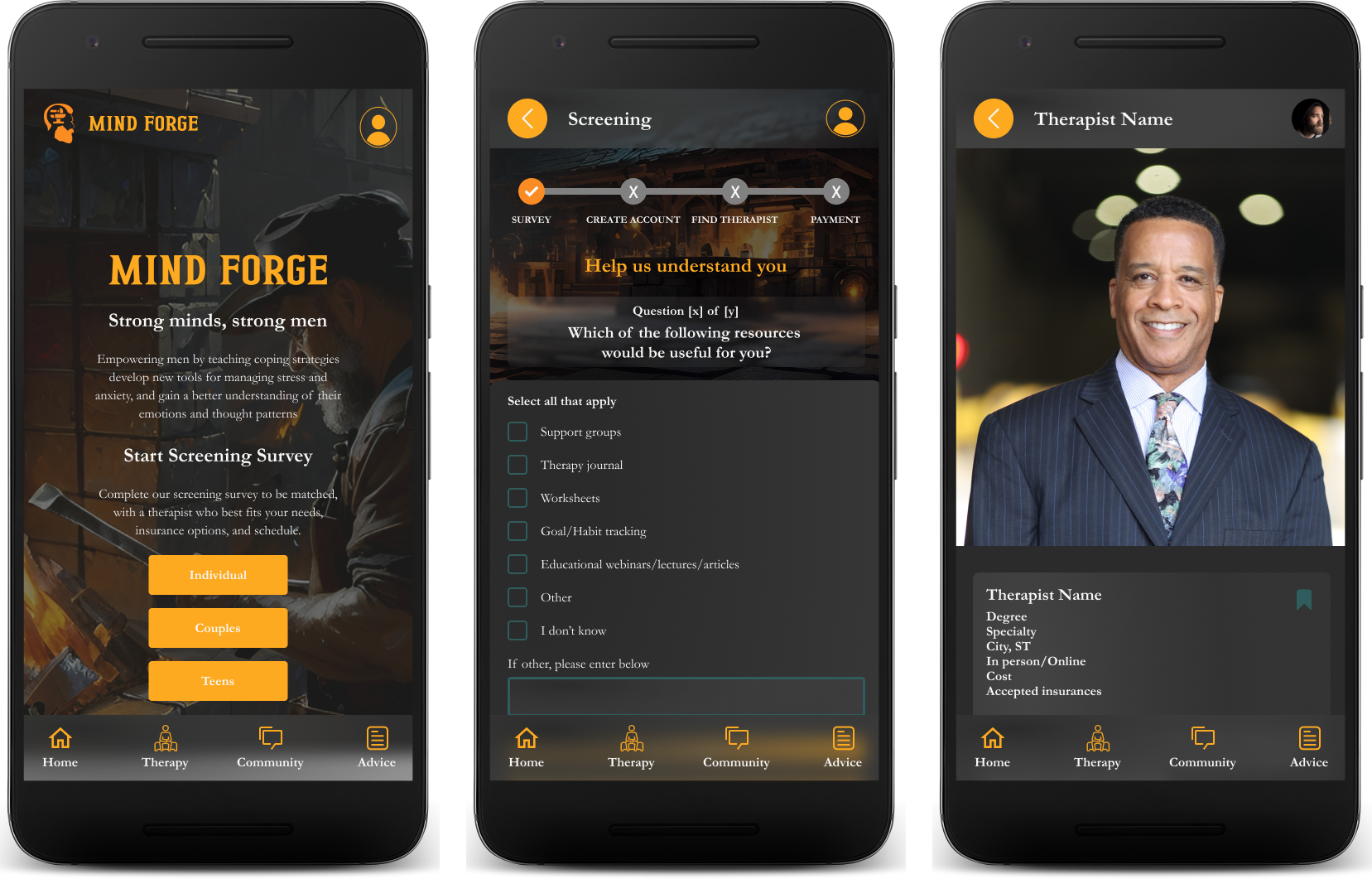
Mind Forge is an application that focuses on men’s mental health. It offers a wide range of features to support users in their journey towards improved well-being. Through Mind Forge, users have the opportunity to seek therapy, select a therapist that aligns with their specific needs, access valuable advice through informative articles, and participate in therapist-guided support groups.
This application was developed as a result of a comprehensive 6-month UX design course that aimed to create impactful projects for the betterment of society. Mind Forge exemplifies the dedication and commitment to social good exhibited throughout the course, providing a valuable resource to address the mental health needs of men.
Disclaimer: prototype performance on mobile devices may be slow due to the use of gradients.
Why Men’s Mental Health
“In 2021 it was reported that there were 22.4 annual male suicides per 100,000 people (Centers for Disease Control and Prevention [CDC], 2022).”
Mental health issues are often overlooked in men, and they are less likely to seek treatment compared to women. There are several reasons for this disparity, including societal expectations, traditional gender roles, and stigma surrounding mental health.
Men may be more prone to underreporting or masking their symptoms. Society often expects men to be stoic, self-reliant, and strong, which can create pressure to hide emotional distress. Men may be less likely to seek help or express vulnerability due to the influence of traditional gender roles, which can result in a reluctance to pursue mental health treatment. Instead, they may resort to self-medicating as a coping mechanism, which can often lead to substance abuse (Benita N. Chatmon, 2020).
Contributing to the lower prevalence of mental illness in men, as reported by the Substance Abuse and Mental Health Services Administration (SAMHSA), could be differences in the types of mental health disorders that are more prevalent in each gender. For example, certain disorders such as depression and anxiety tend to be more commonly diagnosed in women, while conditions like substance abuse and conduct disorders may be more prevalent among men, but underreported (Substance Abuse and Mental Health Services Administration [SAMHSA], 2018).
Mind Forge sets itself apart from other general applications by focusing on the specific needs of men’s mental health. Its purpose strives to address the challenges men may encounter when pursuing therapy online, taking into account their internal experiences and the societal influences that shape their mental health journey.
Research and Planning
I carried out a user survey, interviewed a therapist, and reviewed extensive scholarly research to identify problems men may face when seeking out mental health. It was found that:
- Men did not have time for therapy
- Male therapy is socially stigmatized
- Men thought they had to deal with their problems alone
- Most found therapy helpful and useful practice
- Men wanted to better themselves or move from past trauma
- Finding a therapist who could work on specific needs was difficult
- Group therapy is effective for some men. Some men felt alone in dealing with their struggles
Processes that improved help-seeking attitudes, intentions, or behaviors for men included:
- Using role models to convey information (Sagar-Ouriaghli et al., 2019)
- Psychoeducational material to improve mental health knowledge
- Assistance with recognizing and managing symptoms
- Active problem-solving tasks
- Motivating behavior change
- Content that is built on positive male traits (e.g., responsibility and strength) (Sagar-Ouriaghli et al., 2019)
Based on these findings, I created a persona to tailor my design: Mason is a young retail worker who finds himself in a constant state of depression and listlessness. Born and raised in a western society, Mason understands the importance of mental health. However, his busy schedule and financial situation holds him back from seeking a mental health professional.
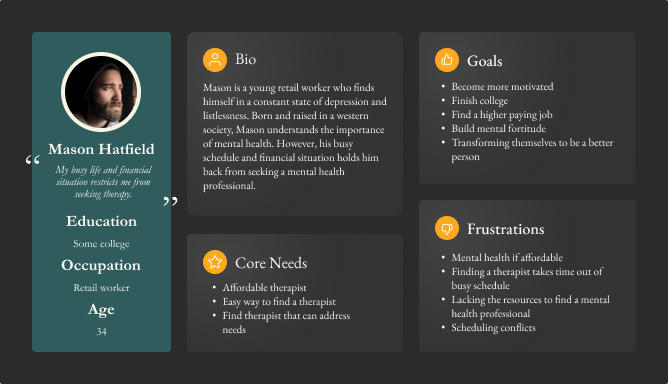
To better understand how users like Jason interact with current mental health applications, this user journey was created:
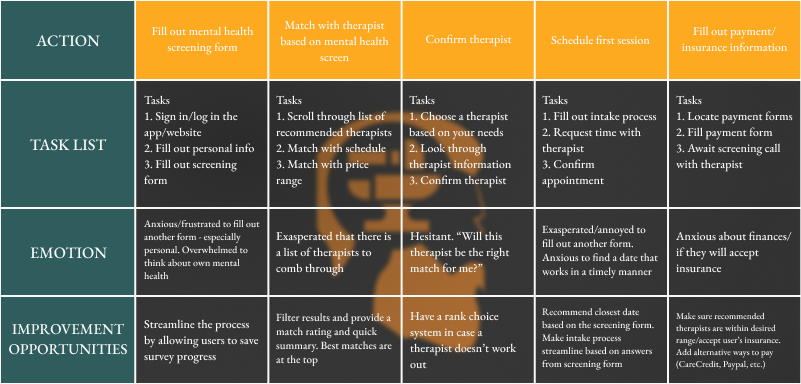
Wireframing and Prototyping
To address the main challenges faced by Mason when seeking therapy, I decided to design a mobile app that would allow the user to find a therapist based on the criteria that would best suit them.
The main way for a prospective man to receive help is to complete an extensive survey. Based on the user’s answer, Mind Forge recommends and displays therapists that would best match their needs.
To kickstart the development of the application, I began with paper wireframes, which helped me visualize and plan the general layout and functionality of the app. Drawing from the knowledge gained through competitive audits, I tailored the layout to meet the specific needs of users seeking therapy efficiently and effortlessly. As a result, the application offers multiple convenient pathways for users to initiate the therapy process, ensuring a smooth and user-friendly experience.
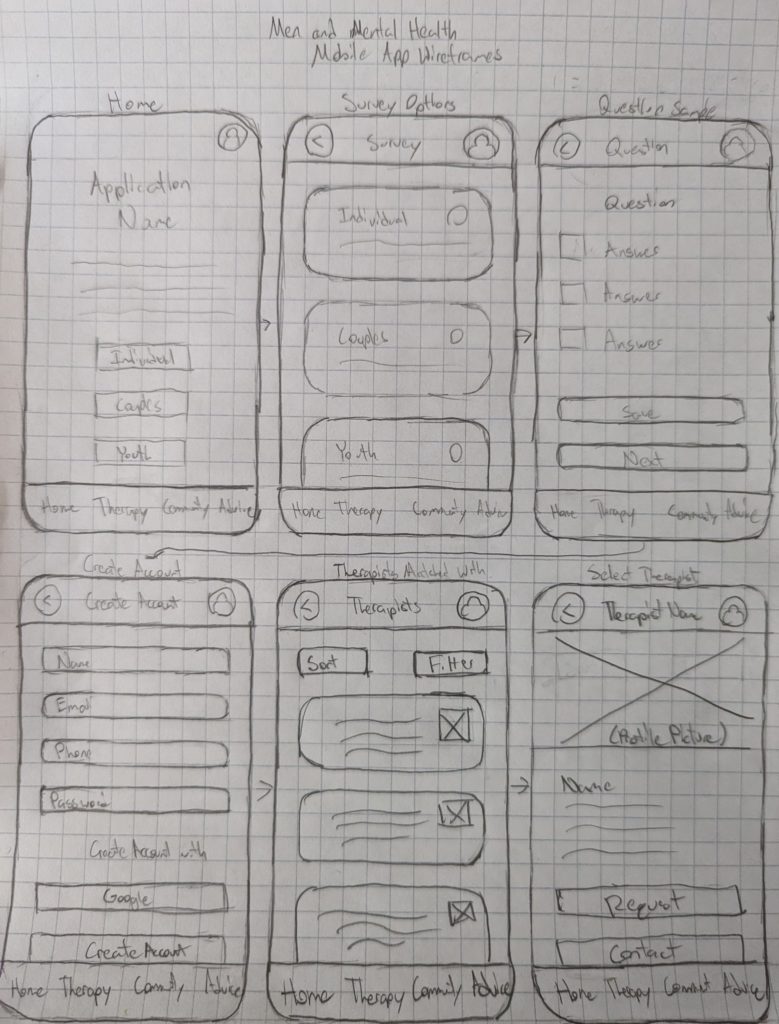
One of my goals was to offer a solution for those who might not have enough time to complete the initial survey in one sitting, so I integrated a save function in the application. By creating an account, users can save their progress and return to the survey whenever they have the time, picking up right where they left off. This feature ensures a more flexible and accommodating user experience.
These paper wireframes were then translated onto a digital wireframe where it was tested. I was able to focus on optimizing the therapy sign up process by conducting 5 rounds of user testing. The feedback given mostly centered around task flow and smaller nuances of the application. Four priorities were identified:
- Unclear button labels
- Fields for “other” answers
- Survey purpose
- Create account process
Digital wireframes
Keeping these priorities at the forefront, I proceeded to develop a prototype that specifically addressed them. To enhance user understanding and engagement, I made several improvements. For instance, I changed the label for requesting the services of a therapist from “Request” to “Book Therapist,” creating a more explicit and action-oriented button.

Right: Prototype with a much clearer action, “Book Therapist”
Additionally, I ensured that the survey’s purpose was prominently displayed on the homepage and reiterated upon completion, making its significance clearer to users. Moreover, I streamlined the process for creating an account to make it more user-friendly by presenting the option to sign in with alternative services “Facebook” and “Google,” first before asking for a password, date of birth, email, and phone number. These enhancements were designed to create a seamless and user-centric experience throughout the application.
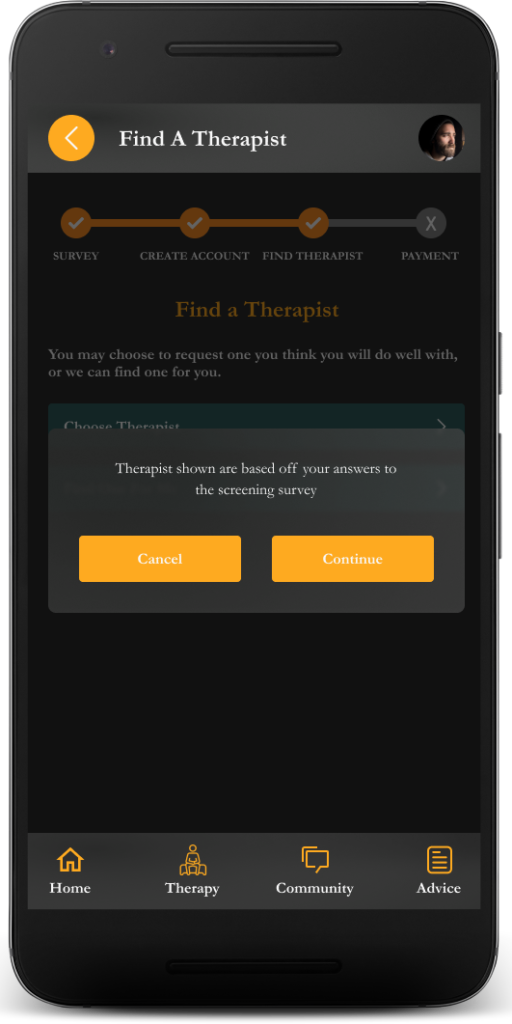
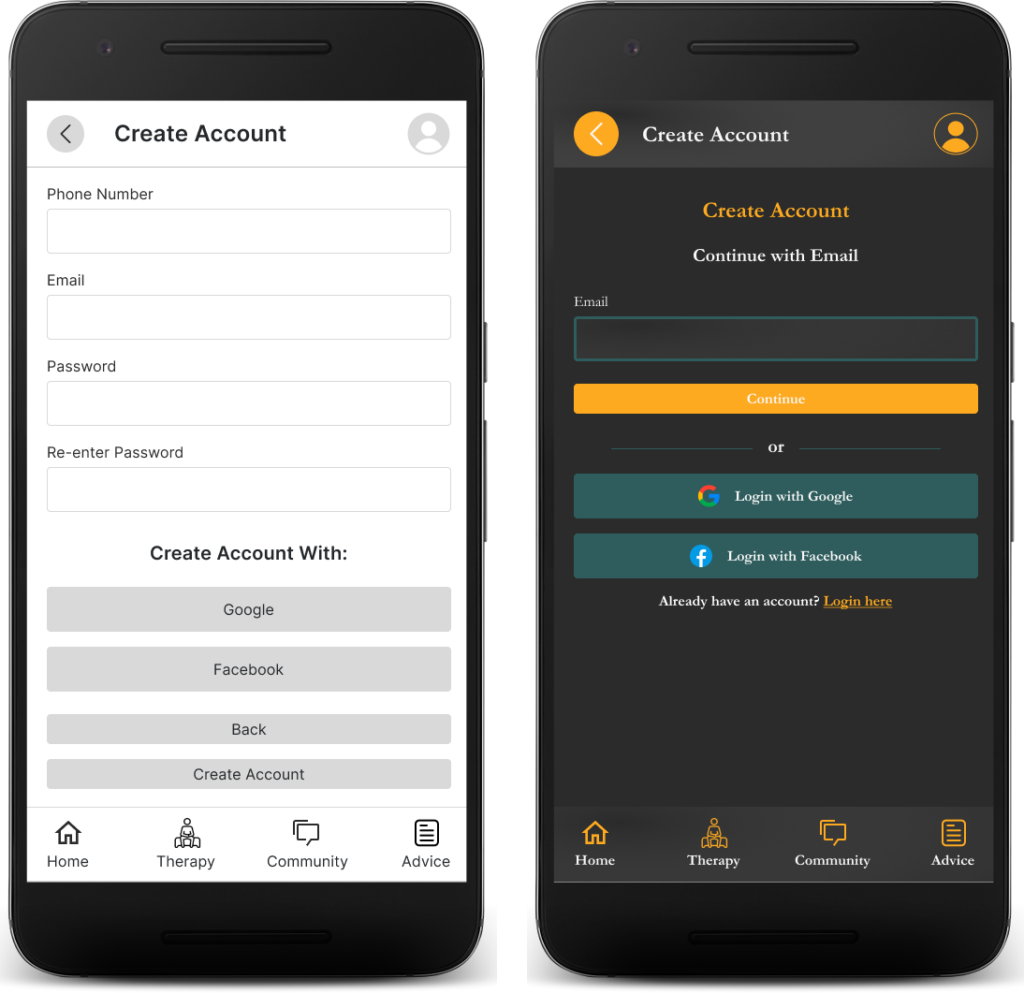
Right: Prototype sign-up method presenting the user with alternatives up front
To promote positive male traits, I chose the name “Mind Forge” for the application and designed it with a strong focus on blacksmithing motifs. Throughout the site, there are subtle elements such as hammers, blacksmithing tongs, fires, anvils, and brick forges, which allude to the art of blacksmithing. Moreover, I incorporated colors associated with this craft. Yellow, symbolizing the tempering of robust tools like knives and hammers, was used. Additionally, a bluish green shade represents the tempering of smaller hardware like springs and gears. To create a unique contrast and embrace a “manly” motif, I incorporated the color black. Together, these design choices aim to celebrate masculinity and inspire a sense of empowerment and self-improvement for male users.

Conclusion
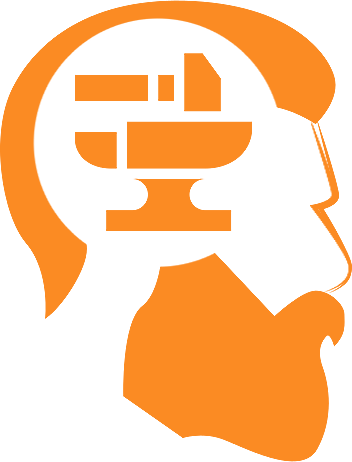
Mind Forge is a purposeful product dedicated to addressing the unique needs of men’s mental health and offering a fresh perspective on male-centered therapy. This subject is sensitive and continuously evolving, as researchers delve deeper into men’s mental well-being, while male opinions about it undergo transformation. Tailoring the application to resonate with the new generation of men presented a significant challenge. Integrating various elements, such as aesthetics, effective messaging to eradicate any stigma around therapy for men, and addressing pain points observed in other therapy apps, has not been extensively explored before.
With this design, my hope is to inspire men to explore the mental health landscape in a more meaningful and effective way. By providing a platform that aligns with their specific needs, Mind Forge aims to encourage men to prioritize their mental well-being, seek therapy without shame, and embrace the journey towards mental health and self-improvement.
What’s Next:
This project is continuously evolving with the aim of incorporating additional essential functionalities to support men in maintaining their therapy sessions effectively. The current focus is to encourage men to take their first step into the world of therapy while addressing societal concerns and reducing stigma surrounding mental health.
In the future, the exploration of a companion web application is planned to enhance the accessibility of therapy services across various devices.
A central hub will be introduced to cater to established therapy patients, providing convenient access to crucial functions such as scheduling appointments, viewing upcoming sessions, maintaining therapy journals, and engaging in telehealth sessions. By centralizing these functions, Mind Forge seeks to simplify the user experience and ensure that important features are easily accessible and efficiently utilized.
Takeaways:
Engaging in this project provided me with invaluable insights into the significance of user and market research in UX design. Our primary objective as UX designers is to create products that cater to users’ needs and goals. Understanding their pain points, challenges beyond the product itself, and their individual requirements profoundly influences the final product’s design.
Conducting a competitive audit allowed me to examine an existing therapy app’s user flow, drawing inspiration and insights to enhance this application. Through user research, I could identify specific pain points experienced by users, enabling me to develop solutions that directly address their concerns.
Furthermore, reading articles and delving into the exploration of positive male traits helped shape the design in a way that encourages men to seek therapy while breaking down societal stigmas surrounding mental health.
All these efforts culminated in a product that effectively addresses men’s mental health needs, fostering a user-centric approach that prioritizes their well-being and creates a positive impact on their lives.
Citations:
Substance Abuse and Mental Health Services Administration. (2018). Key substance use and mental health indicators in the United States: Results from the 2017 National Survey on Drug Use and Health (HHS Publication No. SMA 18-5068, NSDUH Series H-53). Rockville, MD: Center for Behavioral Health Statistics and Quality, Substance Abuse and Mental Health Services Administration. Retrieved from https://www.samhsa.gov/data
Sagar-Ouriaghli, I., MSc, BSc, Godfrey, E., Phd, Bridge, L., MSc, BA, Meade, L., MA, BRMCD, & Brown, J. S., PhD (2019, July 11). Improving Mental Health Service Utilization Among Men: A Systematic Review and Synthesis of Behavior Change Techniques Within Interventions Targeting Help-Seeking. National Library of Medicine. Retrieved July 5, 2023, from https://www.ncbi.nlm.nih.gov/pmc/articles/PMC6560805/
Chatmon, B. N., PhD (2020, August 19). Males and Mental Health Stigma. National Library of Medicine. Retrieved July 5, 2023, from https://www.ncbi.nlm.nih.gov/pmc/articles/PMC7444121/
Centers for Disease Control and Prevention (2022). Suicide Data and Statistics. Retrieved July 5, 2023, from https://www.cdc.gov/suicide/suicide-data-statistics.html